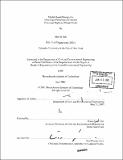| dc.contributor.advisor | Franz-Josef Ulm. | en_US |
| dc.contributor.author | Soh, Melvin, 1979- | en_US |
| dc.contributor.other | Massachusetts Institute of Technology. Dept. of Civil and Environmental Engineering. | en_US |
| dc.date.accessioned | 2008-01-10T16:19:06Z | |
| dc.date.available | 2008-01-10T16:19:06Z | |
| dc.date.copyright | 2003 | en_US |
| dc.date.issued | 2003 | en_US |
| dc.identifier.uri | http://hdl.handle.net/1721.1/40023 | |
| dc.description | Thesis (M.Eng.)--Massachusetts Institute of Technology, Dept. of Civil and Environmental Engineering, 2003. | en_US |
| dc.description | Includes bibliographical references (leaf 64). | en_US |
| dc.description.abstract | In light of the current situation of highway bridge girders today, the Federal Highway Administration (FHWA) is constantly seeking to develop new bridges that can meet and adapt to current and future traffic, minimize environmental impact, require low-maintenance and are economical and easy to install. An Ultra High Performance Concrete (UHPC) bridge girder can meet such goals. It requires less material than ordinary reinforced concrete bridges owing to its considerable mechanical properties, is more durable and easier to install due to the presence of short fibers randomly oriented throughout the material mitigating the need for reinforcing bars. Already developed here at M.I.T. is the two-phase constitutive model for UHPC and the validation thereof through shear and flexural.tests. Preliminary designs have optimized the shape and section heights of the girders as well as their behavior in transferring pre-stressing stresses. What remains to be done is to refine existing cross-sectional designs and investigate new crosssectional designs, especially with reference to slab-thickness and recessed web distances, before a prototype bridge can be built, tested and monitored at the FHWA Turner-Fairbank Highway Research Center in McLean Virginia. Thus the focus of this work is on this last aspect of the design phase of UHPC prototype highway bridge girders. Designs of the highway bridge girders were conducted with the aid of a finite element program that has been verified for the material, UHPC, in question. The designs were assessed against service and ultimate limit state crack-opening criterions. A 2-D model was first analyzed to determine global flexural behavior of the beams, followed by a 3-D model to examine localized strain effects. The results of this work showed that a girder, with a continuous 4-inch top-slab satisfactorily met all performance criteria under both ultimate and service limit state, while other girders with smaller slab thickness fail to meet all these requirements simultaneously. However, a girder with recessed webs, passed the ultimate limit state, and failed the service limit state marginally. From the results of this report we can conclude that, a 4-inch top slab is sufficient to meet all service limit state performance criteria. Should the minute cracks developed under service loads be acceptable under the service limit state, a 2-inch top-slab between webs can be employed only if the webs are recessed inwards to minimize transverse moments. | en_US |
| dc.description.statementofresponsibility | by Melvin Soh. | en_US |
| dc.format.extent | 64 leaves | en_US |
| dc.language.iso | eng | en_US |
| dc.publisher | Massachusetts Institute of Technology | en_US |
| dc.rights | M.I.T. theses are protected by copyright. They may be viewed from this source for any purpose, but reproduction or distribution in any format is prohibited without written permission. See provided URL for inquiries about permission. | en_US |
| dc.rights.uri | http://dspace.mit.edu/handle/1721.1/7582 | |
| dc.subject | Civil and Environmental Engineering. | en_US |
| dc.title | Model-based design of a ultra high performance concrete prototype highway bridge girder | en_US |
| dc.title.alternative | Model based design of a UHPC prototype bridge | en_US |
| dc.type | Thesis | en_US |
| dc.description.degree | M.Eng. | en_US |
| dc.contributor.department | Massachusetts Institute of Technology. Department of Civil and Environmental Engineering | |
| dc.identifier.oclc | 52849223 | en_US |
